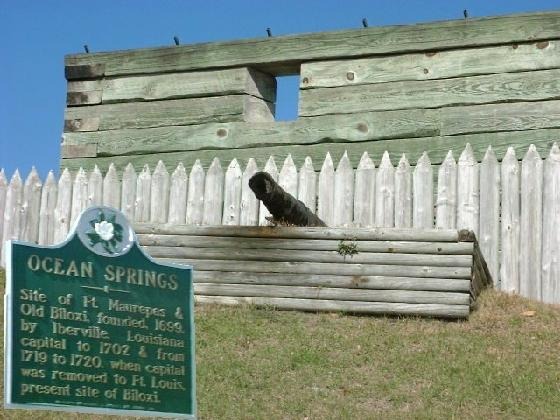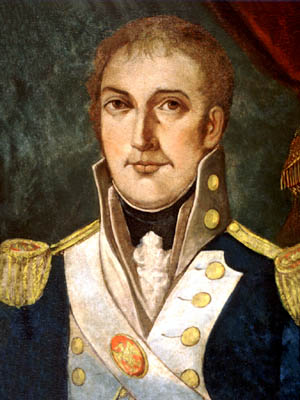|
Sauvolle
The sieur de Sauvolle (1701), known for certainty only by his surname, was the first governor of the French territory of Louisiana. He accompanied the brothers Iberville and Bienville on their first voyage to Louisiana in 1699 and their explorations inland. On May 2, 1699, he was appointed commander of the new Fort Maurepas, and in January 1700 he became the territory's governor. His journal is one of the earliest sources for the history of the region. Sauvolle died suddenly, likely from yellow fever Yellow fever is a viral disease of typically short duration. In most cases, symptoms include fever, chills, loss of appetite, nausea, muscle pains – particularly in the back – and headaches. Symptoms typically improve within five days. In ..., on August 21, 1701. Despite the survival of his journal entries and the journals of Iberville, almost nothing is known about Sauvolle: neither his ancestry nor the year of his birth, nor even much of his name. Iberville me ... [...More Info...] [...Related Items...] OR: [Wikipedia] [Google] [Baidu] |
Jean-Baptiste Le Moyne, Sieur De Bienville
Jean-Baptiste Le Moyne de Bienville (; ; February 23, 1680 – March 7, 1767), also known as Sieur de Bienville, was a French colonial administrator in New France. Born in Montreal, he was an early governor of French Louisiana, appointed four separate times during 1701–1743. He was the younger brother of explorer Pierre Le Moyne d'Iberville. Early life Jean-Baptiste Le Moyne was the son of Charles le Moyne, born in Longueil, near Dieppe, and Catherine Primot (also known as Catherine Thierry), born in Rouen, both cities in the Province of Normandy. Charles le Moyne established his family in the settlement of Ville-Marie (present day Montreal) at an early age and had fourteen children total. Exploration in the New World At the age of seventeen, Bienville joined his brother Iberville on an expedition to establish the colony of Louisiana. Bienville explored the Gulf of Mexico coastline, he discovered around approximately 1699 as far up as into Mobile Bay which was not deep ... [...More Info...] [...Related Items...] OR: [Wikipedia] [Google] [Baidu] |
Fort Maurepas
Fort Maurepas, later known as Old Biloxi, "Pierre Le Moyne, Sieur d'Iberville" (biography), ''Catholic Encyclopedia'', 1907, webpage: gives dates: 13 Feb. 1699, went to the mainland Biloxi, with fort completion May 1, 1699; sailed for France May 4. was developed in colonial French Louisiana (New France) in April 1699 along the Gulf of Mexico (at present-day Ocean Springs, Mississippi). "Fort Maurepas", Mississippi Genealogy, 2002-2008, webpage: Mgenealogy-maurepas Fort Maurepas was designated temporarily as the capital of Louisiana (New France) in 1699. The capital was moved from Biloxi (present-day Mississippi) to Mobile (in present-day Alabama) in 1710, then to New Orleans in 1723 on the Mississippi River. Government buildings in the latter city were still under construction. Toponymy The name ''Biloxi'' in French was spelled ''Bilocci'', in a transliteration of the name of the local Native American tribe. The military camp was also known in French as ''Fort ... [...More Info...] [...Related Items...] OR: [Wikipedia] [Google] [Baidu] |
List Of Colonial Governors Of Louisiana
This is a list of the colonial governors of Louisiana, from the founding of the first settlement by the French in 1699 to the territory's acquisition by the United States in 1803. The Kingdom of France, French and History of Spain (1700-1810), Spanish governors administered a territory which was much larger than the modern U.S. state of Louisiana, comprising Louisiana (New France) and Louisiana (New Spain), respectively. At the same time, there are parts of present-day Louisiana which were historically administered by other European powers, with the most prominent example being the area known as the Florida Parishes, north of Lake Pontchartrain and east of the Mississippi River. This territory was originally part of La Louisiane, French Louisiana, but it was administered by the West Florida, Kingdom of Great Britain for twenty years (1763–83) following the British victory in the French and Indian War. List First French Louisiana (1682–1762) Spanish Louisiana (1762–1802) ... [...More Info...] [...Related Items...] OR: [Wikipedia] [Google] [Baidu] |
Louis XIV Of France
, house = Bourbon , father = Louis XIII , mother = Anne of Austria , birth_date = , birth_place = Château de Saint-Germain-en-Laye, Saint-Germain-en-Laye, France , death_date = , death_place = Palace of Versailles, Versailles, France , burial_date = 9 September 1715 , burial_place = Basilica of Saint-Denis , religion = Catholicism ( Gallican Rite) , signature = Louis XIV Signature.svg Louis XIV (Louis Dieudonné; 5 September 16381 September 1715), also known as Louis the Great () or the Sun King (), was King of France from 14 May 1643 until his death in 1715. His reign of 72 years and 110 days is the longest of any sovereign in history whose date is verifiable. Although Louis XIV's France was emblematic of the age of absolutism in Europe, the King surrounded himself with a variety of significant political, military, and cultural figures, such as Bossuet, Colbert, Le Brun, Le Nôtre, Lully, Mazarin, Molière, Racine, ... [...More Info...] [...Related Items...] OR: [Wikipedia] [Google] [Baidu] |
French Navy
The French Navy (french: Marine nationale, lit=National Navy), informally , is the maritime arm of the French Armed Forces and one of the five military service branches of France. It is among the largest and most powerful naval forces in the world, ranking seventh in combined fleet tonnage and fifth in number of naval vessels. The French Navy is one of eight naval forces currently operating fixed-wing aircraft carriers,Along with the U.S., U.K., China, Russia, Italy, India and Spain with its flagship being the only nuclear-powered aircraft carrier outside the United States Navy, and one of two non-American vessels to use catapults to launch aircraft. Founded in the 17th century, the French Navy is one of the oldest navies still in continual service, with precursors dating back to the Middle Ages. It has taken part in key events in French history, including the Napoleonic Wars and both world wars, and played a critical role in establishing and securing the French ... [...More Info...] [...Related Items...] OR: [Wikipedia] [Google] [Baidu] |
Louisiana (New France)
Louisiana (french: La Louisiane; ''La Louisiane Française'') or French Louisiana was an administrative district of New France. Under French control from 1682 to 1769 and 1801 (nominally) to 1803, the area was named in honor of King Louis XIV, by French explorer René-Robert Cavelier, Sieur de la Salle. It originally covered an expansive territory that included most of the drainage basin of the Mississippi River and stretched from the Great Lakes to the Gulf of Mexico and from the Appalachian Mountains to the Rocky Mountains. Louisiana included two regions, now known as Upper Louisiana (), which began north of the Arkansas River, and ''Lower Louisiana'' (). The U.S. state of Louisiana is named for the historical region, although it is only a small part of the vast lands claimed by France.La Louisiane française 1682-1803 ... [...More Info...] [...Related Items...] OR: [Wikipedia] [Google] [Baidu] |
Pierre Le Moyne D'Iberville
Pierre Le Moyne d'Iberville (16 July 1661 – 9 July 1706) or Sieur d'Iberville was a French soldier, explorer, colonial administrator, and trader. He is noted for founding the colony of Louisiana in New France. He was born in Montreal to French colonist parents. Early life Pierre Le Moyne was born in July 1661 at Fort Ville-Marie (now Montreal), in the French colony of Canada, the third son of Charles le Moyne de Longueuil et de Châteauguay, a native of Dieppe or of Longueuil near Dieppe, Normandy in France and lord of Longueuil in Canada, and of (called Catherine Primot in some sources) from Rouen. He is also known as ''Sieur d'Iberville'' (''et d'Ardillières''). He had eleven brothers, most of whom became soldiers. One, Jacques Le Moyne de Sainte-Hélène, led French and Indian forces in the Schenectady massacre in present-day New York's Mohawk Valley. Charles le Moyne de Longueuil, Baron de Longueuil, was governor of Montreal. Another, Jean-Baptiste Le Moyne Bien ... [...More Info...] [...Related Items...] OR: [Wikipedia] [Google] [Baidu] |
Yellow Fever
Yellow fever is a viral disease of typically short duration. In most cases, symptoms include fever, chills, loss of appetite, nausea, muscle pains – particularly in the back – and headaches. Symptoms typically improve within five days. In about 15% of people, within a day of improving the fever comes back, abdominal pain occurs, and liver damage begins causing yellow skin. If this occurs, the risk of bleeding and kidney problems is increased. The disease is caused by the yellow fever virus and is spread by the bite of an infected mosquito. It infects humans, other primates, and several types of mosquitoes. In cities, it is spread primarily by '' Aedes aegypti'', a type of mosquito found throughout the tropics and subtropics. The virus is an RNA virus of the genus ''Flavivirus''. The disease may be difficult to tell apart from other illnesses, especially in the early stages. To confirm a suspected case, blood-sample testing with polymerase chain reaction is required. A ... [...More Info...] [...Related Items...] OR: [Wikipedia] [Google] [Baidu] |
Governors Of Louisiana (New France)
The governor of Louisiana (french: Gouverneur de la Louisiane) is the head of state and head of government of the U.S. state of Louisiana. The governor is the head of the executive branch of Louisiana's state government and is charged with enforcing state laws. Democrat John Bel Edwards has held the office since January 2016. Qualifications Anyone who seeks to be elected Governor of Louisiana must meet the following qualifications: *have attained the age of 25 years *be an elector *have been a citizen of the United States and a citizen of Louisiana for at least the preceding five years Governors For Governors of Louisiana before the territory was transferred to United States control, see List of colonial governors of Louisiana. Governor of the Territory of Orleans Louisiana was purchased by the United States from France in 1803. On October 1, 1804, Orleans Territory was organized from the southern part of the Purchase, with the remainder being made the District of Louisiana ... [...More Info...] [...Related Items...] OR: [Wikipedia] [Google] [Baidu] |
Year Of Birth Uncertain
A year or annus is the orbital period of a planetary body, for example, the Earth, moving in its orbit around the Sun. Due to the Earth's axial tilt, the course of a year sees the passing of the seasons, marked by change in weather, the hours of daylight, and, consequently, vegetation and soil fertility. In temperate and subpolar regions around the planet, four seasons are generally recognized: spring, summer, autumn and winter. In tropical and subtropical regions, several geographical sectors do not present defined seasons; but in the seasonal tropics, the annual wet and dry seasons are recognized and tracked. A calendar year is an approximation of the number of days of the Earth's orbital period, as counted in a given calendar. The Gregorian calendar, or modern calendar, presents its calendar year to be either a common year of 365 days or a leap year of 366 days, as do the Julian calendars. For the Gregorian calendar, the average length of the calendar year (the ... [...More Info...] [...Related Items...] OR: [Wikipedia] [Google] [Baidu] |







